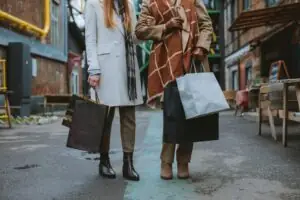Influencers’ Impact on Consumer Optimism
As the holiday shopping season is soon upon us, a lot of brands are turning their attention to using influencers and ambassadors to help support their holiday marketing campaigns.
For the first time in Salesforce Shopping Index history, global e-commerce same-site sales were down 3% year-over-year in the first quarter of 2022.
Two-thirds of this decline was due to a reduction in online traffic overall, with the remaining one-third due to declining consumer spending — all signs that consumer optimism is waning amidst growing concerns about an economic turndown to close out 2022.
According to the Digital Marketing Institute, 49% of consumers depend on the recommendations of influencers from within their own communities, showing the latent potential of increased sales as a direct result of an influencer marketing or brand ambassador partnership.
This is especially true among Gen-Z and Millennials consumers who say they feel they know the influencers they follow on social media platforms like TikTok and Instagram better than their own friends.
That’s an astounding revelation for brand ambassador marketing.
Where older (i.e Gen X) consumers tend to follow traditional celebrities and household names, Gen-Z and Millenial consumers are more likely to follow “handheld names”.
When consumers feel confident in the recommendations of influencers and other online personalities, people with whom they’ve developed relationships, they are more likely to make a purchase because of those recommendations. #TikTokMadeMeBuyIt
Digital Commerce Hits $252 Billion
During the pandemic, consumers turned to online grocery shopping for safety and convenience. Food and beverage brands and retailers, set up online storefronts or partnered quickly in response.
That resulted in aggressive growth – a 57% sales increase in 2020 and 93% sales growth in 2021. Online grocery sales grew an astonishing 93% YoY in the first three months of 2021, setting an unsurpassable baseline. In the first quarter of this year, however, both essential and non-essential retailers saw store traffic return to pre-pandemic levels.
For brands shifting to the holiday shopping season mindset, there’s an opportunity to make social commerce more central to the customer experience, especially when partnering with influencers.
Shopping on social media is a growing trend, and influencers carry an impact on all levels. Micro-influencers have a better understanding of what gets someone to stop mid-scroll. These influential creators are the social media everyman, sharing sales and discounts from partner brands to their audiences.
Connect your SKUs with Instagram to enable more frictionless social product discovery and allow your customers following influencer content to your product pages to purchase without ever leaving their social feeds in the app.
In a social commerce environment, collaborating with influencers is another way for brands to reach consumers ready to shop this holiday season.
Micro-Influencers Drive Record Engagement Rates
While the raw number of followers and subscribers are never a determinant for success, engagement rate is.
In fact, micro-influencers average a whopping 17.96% engagement rate on TikTok.
Luxury fashion house Hugo Boss launched a TikTok branded hashtag challenge to promote the launch of their Christmas collection in December 2020.
The #MerryBOSSmas hashtag challenge received over 3 billion video views with nearly one million video submissions from over 300,000 TikTok influencers.
With Holiday Influencer Marketing, Timing is Key and Content is King
Pre-promotion during the holiday season greatly impacts holiday sales, so if you’re considering some holiday influencer marketing push, it’s time to start strategizing now.
Get ahead of holiday shopping decisions by rolling out and amplifying two rounds of influencer marketing content.
It’s a question of “the early bird getting the worm,” and playing to seasonal trends.
The first round of content should run at the beginning of November, as a Criteo report recently found that new customers in the U.S. typically take two weeks to make a Black Friday purchasing decision.
Planning ahead also gives brands a better chance at working with their dream partners. Many influencers won’t take gift-guide brand inclusions after October 15th.
For consumers already spending time in their social feeds, a well-timed content drop from their favorite influencer can shorten their path to purchase by a few days.
SocialLadder helped hundreds of companies transform their ambassador program with our end-to-end holistic creator management solutions. Want to learn more about how SocialLadder can help you engage your ambassadors with our in-app interactive rewards capabilities? Feel free to schedule a demo with one of our specialists now.



